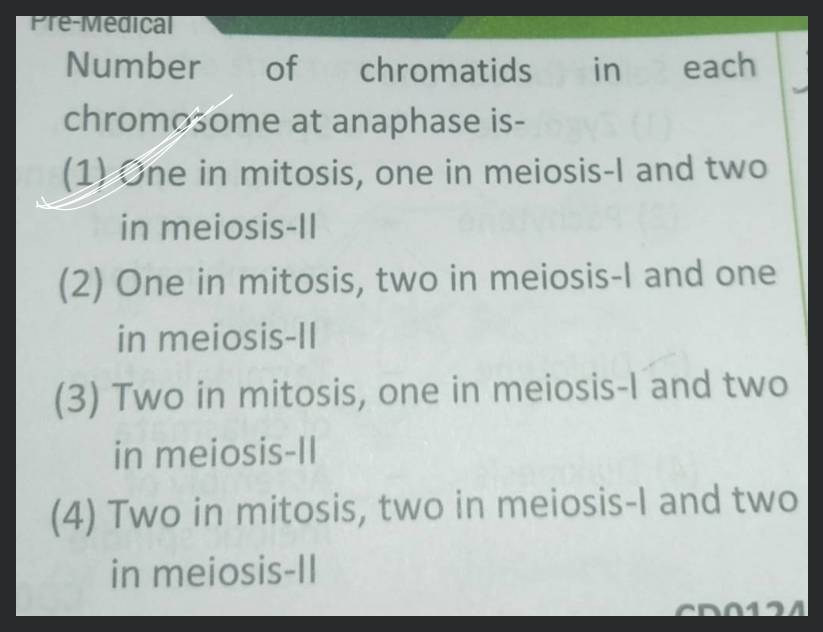Question
Medium
Solving time: 3 mins
The number of chromatids in a chromosome at anaphase is
Found 5 tutors discussing this question
Discuss this question LIVE
6 mins ago
 Text solution
Text solution Verified
Verified
(b) The fourth phase of mitosis is anaphase, it is the process, which separates the duplicated genetic material carried in the parent cell’s nucleus into two daughter cells.
At the initiation of anaphase, the replicated chromosomes known as sister chromatids are amended along the equator of the cell on the central plane.
The sister chromatids are connected at a point known as the centromere.
Meiosis takes place in two stages, that is, meiosis I and meiosis II.
The homologous chromosomes separate and the number of chromosomes in daughter cells gets reduced to half in meiosis I, this is called reductional division.
On the other hand, in meiosis II, the splitting of centromere takes place and the chromosome number stays similar in the daughter cells, thus, it is an equational division.
Thus, the number of chromatids in a chromosome at anaphase is 1 in mitosis and 2 in meiosis.
At the initiation of anaphase, the replicated chromosomes known as sister chromatids are amended along the equator of the cell on the central plane.
The sister chromatids are connected at a point known as the centromere.
Meiosis takes place in two stages, that is, meiosis I and meiosis II.
The homologous chromosomes separate and the number of chromosomes in daughter cells gets reduced to half in meiosis I, this is called reductional division.
On the other hand, in meiosis II, the splitting of centromere takes place and the chromosome number stays similar in the daughter cells, thus, it is an equational division.
Thus, the number of chromatids in a chromosome at anaphase is 1 in mitosis and 2 in meiosis.
Was this solution helpful?
92
Share
Report
Filo tutor solutions (3)
Learn from their 1-to-1 discussion with Filo tutors.
1 mins
Uploaded on: 10/13/2023
Was this solution helpful?
123
Share
Report
6 mins
Uploaded on: 10/17/2022
Was this solution helpful?
150
Share
Report

One destination to cover all your homework and assignment needs
Learn Practice Revision Succeed

Instant 1:1 help, 24x7
60, 000+ Expert tutors

Textbook solutions
Big idea maths, McGraw-Hill Education etc

Essay review
Get expert feedback on your essay

Schedule classes
High dosage tutoring from Dedicated 3 experts
Practice questions from Chapterwise DPP Sheets for Biology NEET (Disha)
Question 1
Easy
Views: 5,480
Question 2
Easy
Views: 5,840
Practice more questions from Cell Cycle and Cell Division
View morePractice questions on similar concepts asked by Filo students
Question 2
Views: 5,792
Question 3
Views: 5,748
Question 4
Views: 5,715


Stuck on the question or explanation?
Connect with our Biology tutors online and get step by step solution of this question.
231 students are taking LIVE classes
| Question Text | The number of chromatids in a chromosome at anaphase is |
| Updated On | Feb 6, 2024 |
| Topic | Cell Cycle and Cell Division |
| Subject | Biology |
| Class | Class 11 |
| Answer Type | Text solution:1 Video solution: 3 |
| Upvotes | 427 |
| Avg. Video Duration | 6 min |





